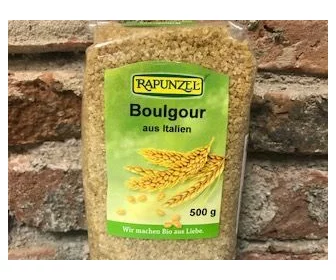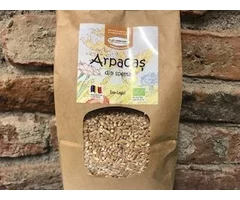
ECO BULGUR 500 GR
ECO BULGUR 500 GR
€3.83
The price includes VAT
-
Availability: Out of stock
- Quantity
-
-
Do you have any questions? Contact us!
+40726.227.796 +40264.406.405 +40364.103.260
MONDAY-FRIDAY
LUNI-VINERI 08:00 - 18:00SATURDAY
09:00 - 14:00
Description
As a source, bulgur (also called boulghoul, boulgour, bulghur or bulghul ) arrived in the Romanian language and gastronomy on the Turkish chain, but its origins can be found in the Ancient Middle East.
Bulgur is the result of processing several types of durum wheat (especially Triticum Durum). Basically, the grains are steamed, then dried and ground to a large granulation, thus obtaining a product extremely easy to integrate into recipes, as it cooks relatively quickly, boiling briefly or soaking in hot or cold water. .
Bulgur, like all other whole wheat derivatives, is extremely healthy precisely because it has not undergone massive processing, which would make it lose its nutritional qualities. It is already widely known that a healthy diet includes whole grains instead of processed products.
What is the difference between bulgur and couscous?
Given that these two foods have only begun to receive the popularity they deserve in recent years, many people do not know the difference between bulgur and couscous. Although, at the base, both have wheat grains and are used in similar preparations, the two differ both in appearance, nutritional value and in terms of processing.
Bulgur is larger than couscous, it does not have that rounded shape, and the treatments applied to wheat to obtain it are based on steam, not water, as is the case with couscous.
What does bulgur taste like?
Bulgur has a light nutty taste and a somewhat crunchy consistency, due to the fact that the wheat grains were not finely ground and turned into flour, but ground. For this reason, most consumers prefer it as an addition to salads, to which it gives consistency or in the form of pilaf, as a side dish.
Bulgur - nutritional content
Bulgur contains:
- B vitamins
- magnesium
- iron
- managn
- fiber
- protein
- carbohydrates
Instead, it is low in saturated fat, sodium and cholesterol, making it suitable for people on a salt-free diet or who want to lose extra pounds.
A cup of cooked bulgur brings your body about 150 calories (83 calories per 100 grams), which doesn't mean much at all, given that you don't need a larger amount to get full.
Bulgur: health benefits
- Bulgur has many fibers in its composition, most of which are insoluble, with the help of which it supports your digestive system, helps peristaltic movements, fights constipation and keeps for a long time the feeling of satiety.
- The same fibers reduce bile secretion and help prevent gallstones.
- Due to the low content of sodium, saturated fats and cholesterol, it supports you in preventing cardiovascular diseases. Moreover, regular consumption of bulgur can lead to decreased triglycerides.
- The B-complex vitamins present in bulgur, liamine, niacin and folic acid support blood circulation.
- Bulgur food gives you energy due to its carbohydrate content. In fact, a cup of cooked bulgur contains about a quarter of the recommended daily requirement of carbohydrates.
- Through its iron content, it supports the processes in the blood, strengthens the immune system and helps you to acquire an elastic and healthy skin.
- The magnesium it brings to your body will help you in the proper functioning of your brain and nervous system in general.
Bulgur contraindications
Bulgur has only one important contraindication: being a product obtained by processing wheat grains, bulgur contains gluten, so it can not be consumed by people suffering from intolerance to this compound (celiac disease).
How to cook bulgur?
To include it in your dishes, let the bulgur soak in water, vegetable soup or other liquids (depending on the recipe you are preparing), for about an hour and a half or even two. The amount of liquid should be 3 times higher than bulgur, ie put about 3 cups of water in a cup of bulgur. If you don't have the patience to wait, you can boil it for about 10 minutes on low heat, until you find that it softens.Bulgur does not have a high price, considering that it is a very productive food: swelling, as I said before, with just one cup you can prepare something good to eat for all members of your family.Bulgur is sold in airtight bags, but if you have opened the bag and have not used it all in one preparation, it is recommended to put it in a container that closes, in turn, airtight, and consume it in the next 6 months. Given its delicious taste, we are sure that this will not be difficult at all.Bulgur recipes
Bulgur is cooked similar to rice or couscous, which means that it fits perfectly in pilafs, soups or broths, offers the consistency of salads or, combined with raisins and nuts, for example, takes the form of a sweet pudding that you can eat as a dessert or snack. In this sense, we recommend the bulgur recipes from the SanoVita blog. There you will find all the details you need to prepare very tasty dishes with this food, and if you have questions about the preparation, we will be happy to answer. You can still find some of the most well-known and interesting bulgur recipes.
Salad tabouleh
The most famous Bulgarian recipe is tabouleh salad (pronounced tabulé , with emphasis on the final vowel), of oriental origin. Basically, the tabouleh recipe is prepared with bulgur, tomatoes, onions, mint and a lot of parsley, which makes it very fresh and extremely interesting in terms of taste. To these are added lemon and cold-pressed sunflower oil or olive oil. Depending on the area from which it comes (Lebanese salad or Turkish salad), it can also receive other ingredients, such as green leafy vegetables or cucumbers, and you are free to adapt it, in turn, according to your own taste.
A word of advice: because taboo salad is eaten cold, great gourmets suggest that it should be kept in the refrigerator for at least an hour before being served.
Bulgur with vegetables
Bulgur is also very good with vegetables, baked or just boiled. You can choose any of your favorite vegetables, cut into cubes and add them in this form over the already cooked bulgur. If the vegetables are slightly crispy, they will combine perfectly with the texture of the bulgur. If you want a softer dish, you can boil the vegetables with bulgur for a minute or two.
Fasting sarmalute with bulgur
In some areas of the country, fasting sarmalute is consumed in beef sheets in which bulgur is put instead of meat or mushrooms. Basically, to the classic ingredients (sautéed onion, broth, and rice) the bulgur is added and then the sarmalute is wrapped and boiled over low heat for an hour - an hour and a half.
Chickpea with chickpeas
Here is another oriental-inspired recipe that brings you a large number of healthy proteins.
ingredients
- 2 large onions
- 200g of naut grain
- 1 cup and a half of bulgur
- 4 tablespoons olive oil
- pepper and salt to taste
- vegetable cream
- fresh parsley or dill
How to prepare the recipe
The chickpeas are left to soak overnight, then rinse and drain. Cut the onion into small pieces and cook in the 4 tablespoons of olive oil. Add the raw chickpeas and 3 cups of water over it, and this composition is left to boil for at least an hour and a half, until the chickpeas are boiled, chewing from time to time. If it seems to you that the liquid has dropped too much, you can add more water, the chickpea needs a lot of liquid, even if it has already absorbed enough overnight (when you left it hydrated), but it also evaporates during boiling. When the chickpeas are almost ready, add the bulgur, leave for another 7-8 minutes and then turn off the heat.
At the end, take it off the heat, season it with salt and pepper to taste and leave the covered pan for another 10 minutes to swell the bulgur a little more. Add sour cream and greens and serve.



